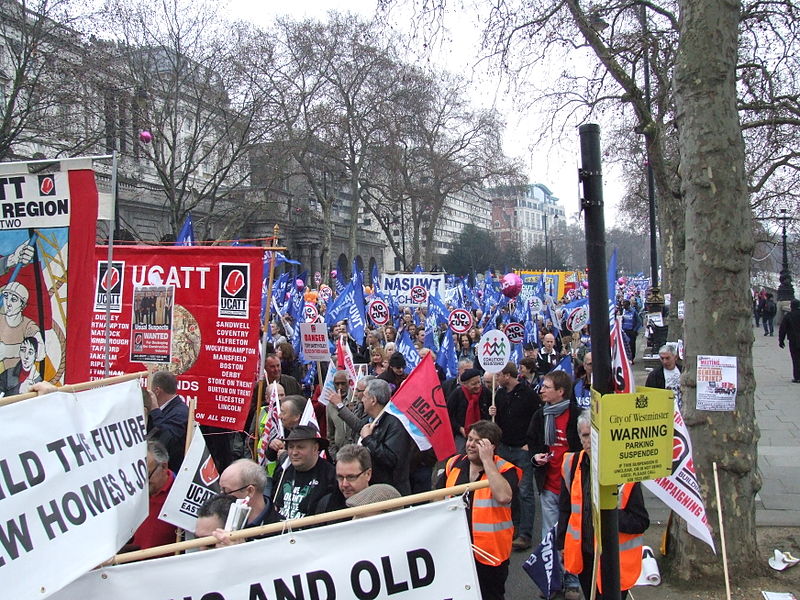The great strike of 1972 - building workers versus employers and the state
By Pat Turnbull
In 1972, after a national strike, building workers achieved the largest single pay increase ever negotiated in the building industry: an immediate pay increase of £6 per week for craftsmen and £5 per week for labourers. This was on a previous national minimum rate of just £20 for a skilled worker and £17 for a labourer. It was a magnificent victory for the workers and their trade unions.
At the time working conditions on building sites were second only to coal mines for fatalities and serious injuries. Facilities like toilets, washbasins, lockers and so on were few and far between. Trade union organisation was hard because of the nature of the industry, where workers moved from one site to another, and organising to defend wages and working conditions had to start all over again with a new group of people. To make it even harder, the employers funded a secret organisation, the Economic League, to maintain a blacklist and keep active trade unionists off the sites.
Organisation was also made harder by a payment system called ‘the lump’. The workers were not seen as employees of the building firm. Instead they were regarded as ‘self-employed’ and were paid a lump sum of money for the work they did each day or week, out of which they had to pay their tax and national insurance. They had various allowances for travel, clothes, lodgings, tools etc that were signed off by the employer, and paid income tax on a much smaller amount than a directly employed worker.
What the lump meant was that workers were trading off working conditions and health and safety on sites for higher pay. Many employers refused to take on direct labour. They knew many would be trade unionists ready to fight collectively for better pay and conditions, which had to be negotiated afresh on each site, and that the ‘lumpers’ would dilute the unions’ strength.
THE STRIKE
1972 saw the highest number of strike days in Britain since the General Strike of 1926. The Conservative government called a state of emergency twice, in February during the miners’ strike, famous for the battle of Saltley Gates coke depot, which involved 15,000 trade unionists, and in August during the dockers’ dispute. Attempts by the government to use the Industrial Relations Act 1971 were a failure.
The National Joint Council of the builders’ unions was formed of four unions: the Union of Construction, Allied Trades and Technicians (UCATT); the Transport and General Workers’ Union (TGWU); the National Union of General and Municipal Workers (NUGMW); and the Furniture, Timber and Allied Trades Union (FTAT). The joint council submitted a pay claim for £30 a week and a basic 35-hour week for all trades. The National Federation of Building Trades Employers rejected the demands and in May 1972, the builders’ unions called a national strike. First they called out the members in the big towns and cities, on the bigger, better organised sites. Some employers conceded the claim but the unions wanted the agreement to be national. So in August an all-out strike was called and union members began to organise flying pickets to go to smaller, out of the way sites, to persuade the workers to support the strike.
The tactic was successful and on Tuesday 14th September 1972 the union side agreed the settlement with the employers, though without the reduction in the working week. It was a massive victory. One of the least well-organised groups of workers had taken on the employers and won.
But some of the building workers were to pay a heavy price as the employers sought their revenge. The group of pickets known as the Shrewsbury 24 were falsely accused of offences while picketing on September 6th. They only had their convictions on these trumped up charges quashed at the Court of Appeal on 23 March 2021 after a huge and persistent battle had been conducted all the years since their trials of 1973 and 1974. By then six of the 14 final appellants had died. The heaviest penalties were paid by Des Warren, who was sent to prison for three years, Ricky Tomlinson (later to become a well-known actor) who was given a two year sentence, and John McKinsie Jones with nine months.
Among the charges levelled at the pickets was one of conspiracy. At his trial in 1973, Des Warren said from the dock: ‘The conspiracy began with the miners giving the government a good hiding last year. It developed when the government was forced to perform legal gymnastics in getting five dockers out of jail after they had only just been put there. The conspiracy was between the Home Office, the employers and the police…
‘The question was hovering over the case from the very first day: why were there no arrests on the 6th September? That would have led to the even more important question of when was the decision to proceed taken. Where did it come from? What instructions were issued to the police? And by whom? There was your conspiracy.
‘The jury in this trial were asked to look upon the word ‘intimidation’ as having the ordinary everyday meaning. My interpretation is ‘to make timid’, or ‘to dispirit’, and when the pickets came to this town to speak to the building workers it was not with the intention of intimidating them. We came here with the intention of instilling the trade union spirit into them, and not to make them timid, but to give them the courage to fight the intimidation of the employers in this area.’
Many thanks to the Shrewsbury 24 Official Campaign website for all the information carried in this article. Jim Arnison’s book about the strike ‘The Shrewsbury Three: Strikes, Pickets and “Conspiracy”’, and Des Warren’s autobiography ‘The Key to my Cell’ are also available from the campaign.

UCATT banner - Photo by Clem Rutter






